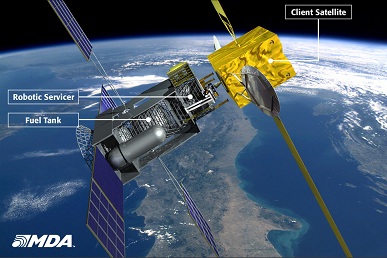 |
| Credits: MDA |
MDA (MacDonald, Dettwiler and Associates Ltd.) is a Canadian company that was incorporated in 1969 by two British Columbia entrepreneurs, John MacDonald and Werner Dettwiler. The company offers a broad spectrum of services. Currently, MDA is developing a Space Infrastructure Servicing (SIS) spacecraft that would operate as a refueling depot for communication satellites in geosynchronous orbit.
Geostationary communication satellites have to perform regular orbital stationkeeping maneuvers, which need delta-v of approximately 50 m/s/year (this translates into fuel consumption). As a result, the lifespan of a satellite is proportional to the amount of fuel it carries onboard, even if most satellites are capable of operating beyond this lifespan. MDA’s SIS system would extend the operational lifespan of these satellites and save satellite operators a lot of money (refueling a satellite would save the operators the cost of building and launching a new satellite).
A typical SIS mission profile not only includes satellite refueling, but also cleaning orbital slots by pushing dead satellites into graveyard orbits. This would also be a money saver because orbital slots are quite expensive.
However, there are challenges. The satellites currently operating are not designed to be serviced/refueled while on orbit (the Hubble Space Telescope is a notable exception). And this will make the refueling maneuver quite complicated… the servicing satellite has to remove a part of the thermal protection blanket of the target spacecraft before connecting to an internal fuel line.
In a March 15, 2011, press release, MDA announced that Intelsat S.A. entered into an agreement with MDA for the servicing of Intelsat’s operational satellites. On-orbit servicing is to be performed by a space-based service vehicle provided by MDA. From the press release:
“The SIS vehicle is expected to be the first of its kind, utilizing a sophisticated robotics and docking system. This system will be based on work that MDA has previously performed for NASA, the Canadian Space Agency and various Department of Defense agencies. The SIS vehicle’s robotic arm will not only be used in refueling, but could also be used to perform critical maintenance and repair tasks, such as releasing jammed deployable arrays and stabilizing or towing smaller space objects or debris. Intelsat, the world’s largest operator of commercial satellites in the geosynchronous arc, is expected to provide flight operations support for the SIS vehicle for the life of the mission.”
The services to be provided by MDA to Intelsat are estimated at more than US$280 million. In the June 17, 2011, press release, MDA also announced that it is extending by three months the requirements definition phase of its SIS initiative.
Needless to say, on-orbit servicing will be a very lucrative endeavor. It also has a strategic importance. Very expensive LEO observation satellites used by the military would benefit from such on-orbit services. Also, NASA is under a tremendous budget pressure. And this can be an answer to the question why NASA would move forward with its own on-orbit servicing initiative.
NASA will demonstrate in-orbit satellite refueling at the International Space Station. MDA-built Dextre, equipped with special tools, will cut through a satellite exterior shell and pump fuel into a mock satellite.
The first thing that comes to mind is that a NASA competition may put the MDA SIS system at risk. Does anyone remember the Avro Canada CF-105 Arrow?










 Subscribe to blog posts using RSS
Subscribe to blog posts using RSS










